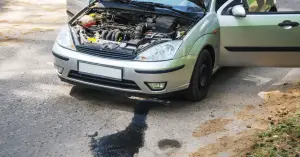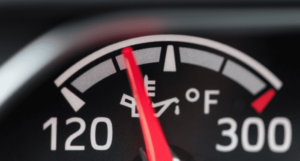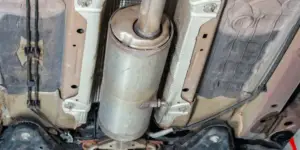
If your car begins to leak oil, it is only natural to feel stress. However, confusion will probably play a part, too. After all, this problem comes with plenty of questions, such as why the oil leak may only occur on one side. Let’s explore what to do if you have an oil leak on the right side of the engine!
An oil leak on the right side of the engine is typically caused by a broken head gasket, which can cause significant leaking of oil that appears only on one side of the engine. If hiring a professional is not an option, you must replace the broken head gasket using an approved sealant product.
In this article, we will examine the possible causes for an oil leak on the right side of the engine. We’ll also go over how to potentially fix the problem, as well as answer some frequently asked questions on the topic. By the conclusion, what to do if you have an oil leak on the right side of the engine should be clear. Let’s get started!
Why Oil Is Leaking From the Right Side of the Engine
The first step to overcoming any problem is finding out the cause. First, it is essential to determine whether or not the liquid leaking out of the vehicle is actually oil. Of course, the first sign drivers typically notice are the black or dark puddles under a car. Pay close attention to the areas where one usually parks to see signs of a repeated stain.
Secondly, one can often tell their car is leaking oil if they detect a burning smell. This is caused by oil dripping not onto the ground, but onto a different part of the car. When this part of the car heats up, you get the smell of burning oil.
You can also often tell that a car is leaking oil by checking on the actual oil levels. This can be done by removing the oil dipstick from the marked part of the engine.
Once you know that your car is definitely leaking oil and it seems to be coming from the right side, it is likely one of the following reasons:
- Damaged Gasket
- Faulty Oil Filter
- Broken Seals
- Improperly Tightened Oil Drain Plug
- Broken Oil Pan
Now that we’ve shown you some of the most common causes of oil leaking on the right side of the engine, we’ll provide you with a little more of an explanation of each, as well as some insight into what to do when you diagnose the problem.
1. Damaged Gasket
A damaged gasket is truly the most likely cause of oil that is leaking specifically on the right side of a car engine. A gasket is very simply a mechanical seal that fills up spaces between several surfaces meant to mate; their whole purpose is to stop an oil leak. Therefore, when you see oil dripping from the right side of your engine, a broken gasket is likely the culprit!
There are a few different kinds of gaskets, all of which could be to blame for leaking oil. These include the valve cover gasket, the oil pan gasket, and the timing cover gasket. However, when oil is leaking from the right side of the engine, it is probably a broken cylinder head gasket.
The cylinder head gasket breaks because of many problems. Sometimes it is simple wear and tear, sometimes the load and compression or oil pressure are too much for the vehicle, and sometimes extreme temperatures or conditions can weaken it.
The question is, what should you do about a damaged gasket? The first method you might want to try is simply calling a mechanical professional. Unfortunately, repairing a blown gasket costs quite a bit, whether you hire a professional or try to do it yourself.
DIY Repair
If you do not have car insurance that covers the repairs, you can do it on your own, but the cost will be upward of $1000 for supplies. That said, it is definitely possible to do on your own!
You’ll need a gasket sealing product. You will have to remove the battery cables so that you don’t have to deal with sparks flying while you work.
Next, make sure to drain the coolant to avoid a mess of water and a waste of time. After removing the exhaust manifolds, intake piping, and timing chain or belt, you’ll be able to reach the cylinder head and work more effectively.
Carefully remove the cylinder head of the gasket with half-turns of the bolts. Then, install new head gaskets with a similar process, taking care to check for cracks. All you need to do after is to reassemble the pieces you needed to remove!
As previously mentioned, this process is not only costly, but time consuming, and if you are not familiar with engine assembly, it may be more worthwhile to pay for a professional to handle the damaged gasket.
2. Faulty Oil Filter
When oil filters become loose, or aren’t in their proper location, the engine is very likely to begin leaking oil. Your oil filter may not have been displaced at all; it is possible that any debris in the engine have blocked the filter. This is why most car experts recommend replacing this important piece every six months or so.
However, if your car has a faulty oil filter, we recommend replacing it altogether. Luckily, getting this done is much easier than trying to replace or re-seal a broken gasket! You can even have the professionals who change your oil regularly replace it in the same visit.
3. Broken Seals
When a car’s seals crack or break, an oil leak is forthcoming. After all, seals within the engine are primarily there to keep the car from leaking oil! The worst part about this is that a seal can be pretty complex to replace. Although the seal itself is a part that rarely costs more than $50, it takes a professional removal of the whole engine to fix.
That said, you can purchase a type of seal leak additive and attempt to apply it yourself.
4. Improperly Tightened Oil Drain Plug
Oil drain plugs are essential for keeping oil where it belongs in the engine. However, if you tighten an oil drain plug incorrectly, it becomes the enemy of this goal! Typically, if a mechanic or a novice has tightened the oil drain plug too loosely, an oil leak will occur.
However, over-tightening the plug could cause the threads of the plug itself to wear down, and eventually loosen it. In this case, you’ll need to purchase and install a new plug or hire a mechanic to do so.
5. Broken Oil Pan
Oil pans are meant to catch the drips of oil from a car. When it becomes damaged, you may notice oil stains indicative of a leak under your car. They can be damaged by hitting speed bumps too hard, driving over rough roads, or getting into car accidents.
Oil pans that are damaged must either be sealed or replaced, usually by a professional.
Conclusion
If you have an oil leak on the right side of your engine, examine the leak first to determine that it is actually oil. You can do this by checking the oil levels using the dipstick or looking at the stain itself. After you identify the leak, you must determine what is causing it. Once you’ve figured out the cause, you can either fix it yourself or contact a trusted mechanic to resolve it for you. Either way, you need to fix it to avoid staining and other vehicle related issues.




![Coolant Still Under Pressure When Cold [FIXED] radiator-cap](https://carzaza.com/wp-content/uploads/2024/02/radiator-cap-300x150.png)








